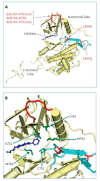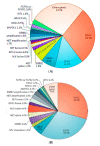Treatment of Brain Metastases of Non-Small Cell Lung Carcinoma
- PMID: 33435596
- PMCID: PMC7826874
- DOI: 10.3390/ijms22020593
Treatment of Brain Metastases of Non-Small Cell Lung Carcinoma
Abstract
Lung cancer is one of the most common malignant neoplasms. As a result of the disease's progression, patients may develop metastases to the central nervous system. The prognosis in this location is unfavorable; untreated metastatic lesions may lead to death within one to two months. Existing therapies-neurosurgery and radiation therapy-do not improve the prognosis for every patient. The discovery of Epidermal Growth Factor Receptor (EGFR)-activating mutations and Anaplastic Lymphoma Kinase (ALK) rearrangements in patients with non-small cell lung adenocarcinoma has allowed for the introduction of small-molecule tyrosine kinase inhibitors to the treatment of advanced-stage patients. The Epidermal Growth Factor Receptor (EGFR) is a transmembrane protein with tyrosine kinase-dependent activity. EGFR is present in membranes of all epithelial cells. In physiological conditions, it plays an important role in the process of cell growth and proliferation. Binding the ligand to the EGFR causes its dimerization and the activation of the intracellular signaling cascade. Signal transduction involves the activation of MAPK, AKT, and JNK, resulting in DNA synthesis and cell proliferation. In cancer cells, binding the ligand to the EGFR also leads to its dimerization and transduction of the signal to the cell interior. It has been demonstrated that activating mutations in the gene for EGFR-exon19 (deletion), L858R point mutation in exon 21, and mutation in exon 20 results in cancer cell proliferation. Continuous stimulation of the receptor inhibits apoptosis, stimulates invasion, intensifies angiogenesis, and facilitates the formation of distant metastases. As a consequence, the cancer progresses. These activating gene mutations for the EGFR are present in 10-20% of lung adenocarcinomas. Approximately 3-7% of patients with lung adenocarcinoma have the echinoderm microtubule-associated protein-like 4 (EML4)/ALK fusion gene. The fusion of the two genes EML4 and ALK results in a fusion gene that activates the intracellular signaling pathway, stimulates the proliferation of tumor cells, and inhibits apoptosis. A new group of drugs-small-molecule tyrosine kinase inhibitors-has been developed; the first generation includes gefitinib and erlotinib and the ALK inhibitor crizotinib. These drugs reversibly block the EGFR by stopping the signal transmission to the cell. The second-generation tyrosine kinase inhibitor (TKI) afatinib or ALK inhibitor alectinib block the receptor irreversibly. Clinical trials with TKI in patients with non-small cell lung adenocarcinoma with central nervous system (CNS) metastases have shown prolonged, progression-free survival, a high percentage of objective responses, and improved quality of life. Resistance to treatment with this group of drugs emerging during TKI therapy is the basis for the detection of resistance mutations. The T790M mutation, present in exon 20 of the EGFR gene, is detected in patients treated with first- and second-generation TKI and is overcome by Osimertinib, a third-generation TKI. The I117N resistance mutation in patients with the ALK mutation treated with alectinib is overcome by ceritinib. In this way, sequential therapy ensures the continuity of treatment. In patients with CNS metastases, attempts are made to simultaneously administer radiation therapy and tyrosine kinase inhibitors. Patients with lung adenocarcinoma with CNS metastases, without activating EGFR mutation and without ALK rearrangement, benefit from immunotherapy. This therapeutic option blocks the PD-1 receptor on the surface of T or B lymphocytes or PD-L1 located on cancer cells with an applicable antibody. Based on clinical trials, pembrolizumab and all antibodies are included in the treatment of non-small cell lung carcinoma with CNS metastases.
Keywords: ALK; EGFR; brain metastases; immunotherapy; non-small cell lung carcinoma; treatment.
Conflict of interest statement
The authors declare no conflict of interest.
Figures












Similar articles
-
Detection of an EML4-ALK fusion mutation secondary to epidermal growth factor receptor-tyrosine kinase inhibitor (EGFR-TKI) therapy for lung cancer: a case report.Ann Palliat Med. 2022 Jul;11(7):2503-2509. doi: 10.21037/apm-22-744. Ann Palliat Med. 2022. PMID: 35927783
-
Tyrosine Kinase Inhibitors With and Without Up-Front Stereotactic Radiosurgery for Brain Metastases From EGFR and ALK Oncogene-Driven Non-Small Cell Lung Cancer (TURBO-NSCLC).J Clin Oncol. 2024 Oct 20;42(30):3606-3617. doi: 10.1200/JCO.23.02668. Epub 2024 Jul 24. J Clin Oncol. 2024. PMID: 39047224
-
Acquired EML4-ALK fusion and EGFR C797S in cis mutation as resistance mechanisms to osimertinib in a non-small cell lung cancer patient with EGFR L858R/T790M.Anticancer Drugs. 2023 Nov 1;34(10):1146-1150. doi: 10.1097/CAD.0000000000001489. Epub 2022 Dec 23. Anticancer Drugs. 2023. PMID: 36728908
-
Brain Metastases in NSCLC - are TKIs Changing the Treatment Strategy?Anticancer Res. 2015 Nov;35(11):5797-806. Anticancer Res. 2015. PMID: 26504000 Review.
-
Strategies to overcome acquired resistance to EGFR TKI in the treatment of non-small cell lung cancer.Clin Transl Oncol. 2019 Oct;21(10):1287-1301. doi: 10.1007/s12094-019-02075-1. Epub 2019 Mar 12. Clin Transl Oncol. 2019. PMID: 30864018 Review.
Cited by
-
Branch Chain Amino Acid Metabolism Promotes Brain Metastasis of NSCLC through EMT Occurrence by Regulating ALKBH5 activity.Int J Biol Sci. 2024 Jun 29;20(9):3285-3301. doi: 10.7150/ijbs.85672. eCollection 2024. Int J Biol Sci. 2024. PMID: 38993559 Free PMC article.
-
A Real-World Analysis of Patients with Untreated Metastatic Epidermal Growth Factor Receptor (EGFR)-Mutated Lung Adenocarcinoma Receiving First-Line Erlotinib and Bevacizumab Combination Therapy.Oncol Ther. 2021 Dec;9(2):489-503. doi: 10.1007/s40487-021-00152-6. Epub 2021 May 15. Oncol Ther. 2021. PMID: 33990928 Free PMC article.
-
Real-world treatment and prognostic factors for survival in ALK+ non-small cell lung cancer (NSCLC) patients with brain metastases in China.Thorac Cancer. 2023 Jan;14(3):237-245. doi: 10.1111/1759-7714.14739. Epub 2022 Nov 21. Thorac Cancer. 2023. PMID: 36411716 Free PMC article.
-
Clinical Characteristics and Therapeutic Outcomes of Metastatic Peritoneal Carcinomatosis in Non-Small-Cell Lung Cancer.Cancer Manag Res. 2021 Sep 29;13:7497-7503. doi: 10.2147/CMAR.S330103. eCollection 2021. Cancer Manag Res. 2021. PMID: 34616179 Free PMC article.
-
Refining Lung Cancer Brain Metastasis Models for Spatiotemporal Dynamic Research and Personalized Therapy.Cancers (Basel). 2025 May 7;17(9):1588. doi: 10.3390/cancers17091588. Cancers (Basel). 2025. PMID: 40361513 Free PMC article. Review.
References
-
- Didkowska J., Wojciechowska U. Cancer in Poland in 2017. The Maria Sklodowska-Curie Memorial Cancer Center; Warsaw, Poland: 2017.
Publication types
MeSH terms
Substances
LinkOut - more resources
Full Text Sources
Other Literature Sources
Medical
Research Materials
Miscellaneous

